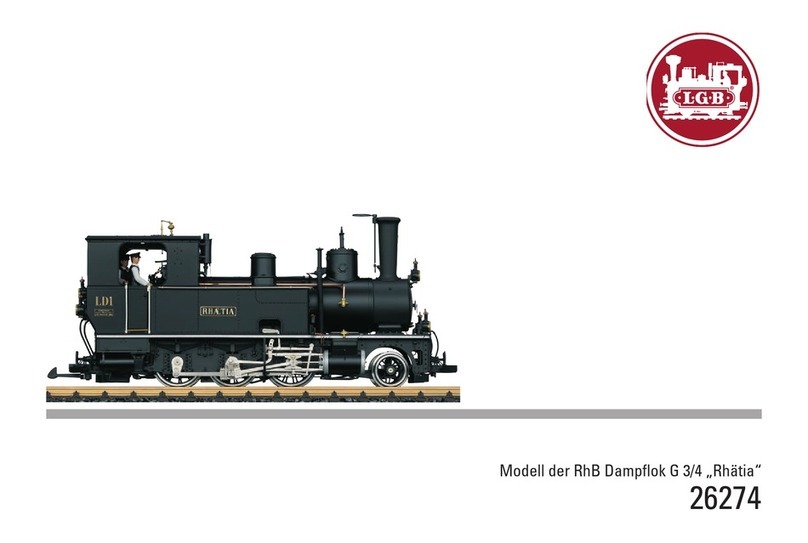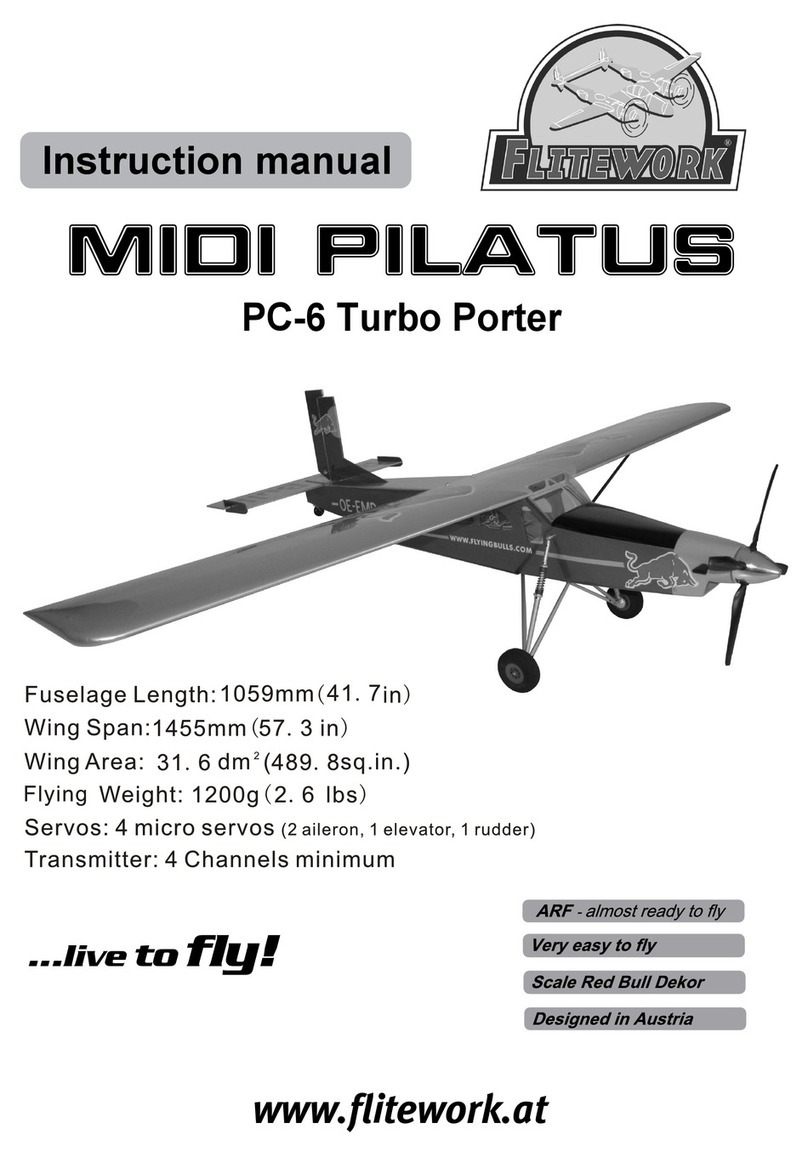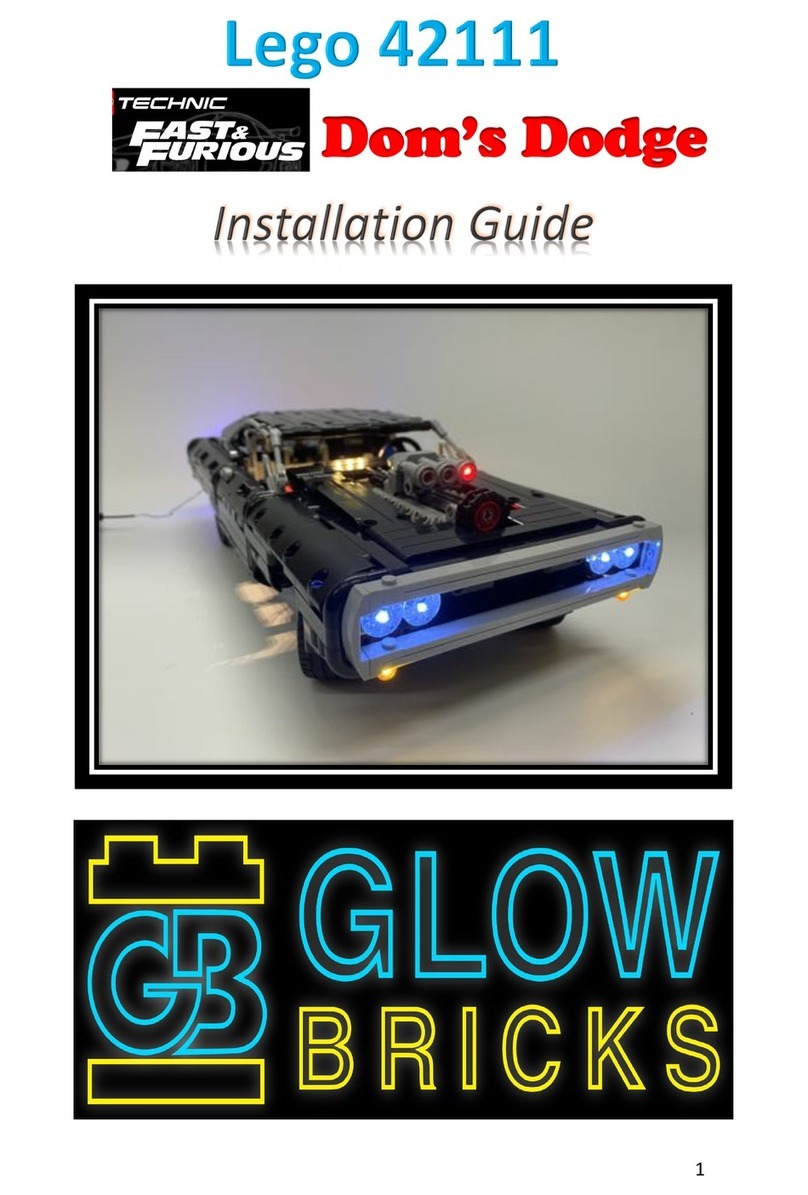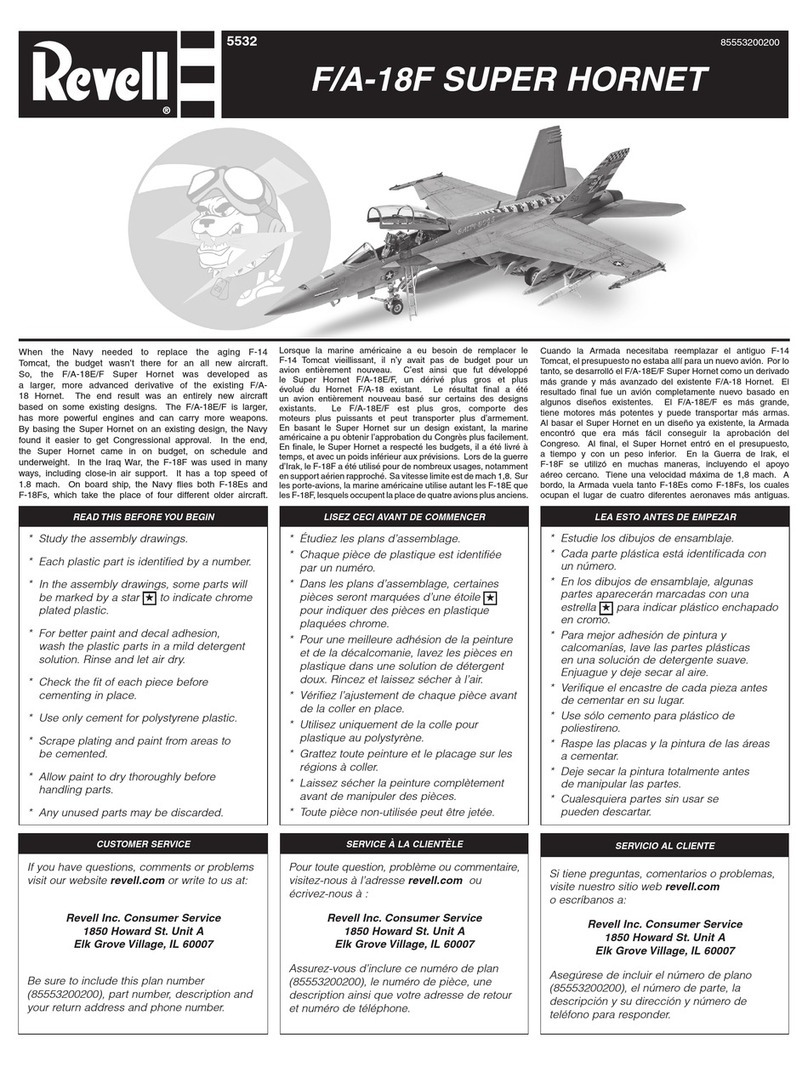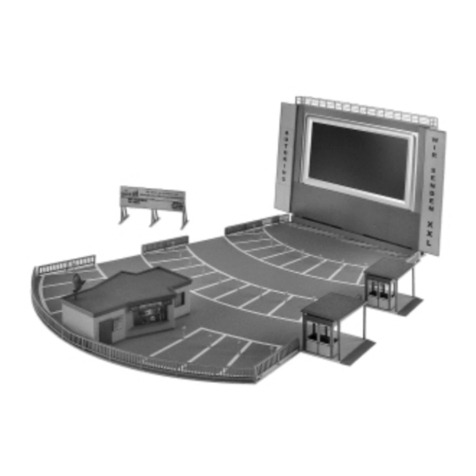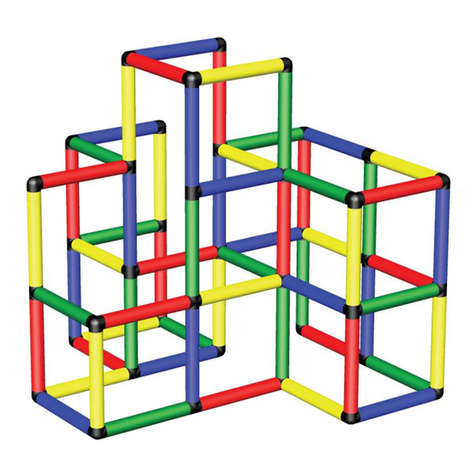ElectroFlying Go-Go Dancer User manual

ElectroFlying, Inc.
2547 83rd Court North,Minneapolis,MN 55444
763-560-5529 • contactefm@electroying.com
© 2005, ElectroFlying, Inc. All Rights Reserved
Rev. #1.3 – 9/14/2007
Go-Go Dancer Instruction Manual
Sport Park Flyer Electric R/C Aircraft
Designed and Drawn by Steven E. Pauley • © 2005, ElectroFlying, Inc. All Rights Reserved
Wing Span: 26” Length: 25.6” Wing Area: 163 sq. in. Weight: 6.8 oz. Wing Loading: 6 oz. per sq. ft.
2 Cell 640 mAh LiPoly (7.4 v) @ 4.2 amps. Total Input Watts: 30 or 75 watts per lb.
Motor: GoBrushless V1 16T Outrunner and Thunderbird 9 Controller Prop: 6” x 4” Electric
Transmitter: 4-Channel Receiver: Micro 4 channel Servos: 3 Hitec HS-45HB

Go-Go Dancer - INTRODUCTION 2
M O D E L S
Read through this manual before starting construction. It contains important
instructions and warnings concerning the assembly and use of this model.
Go-Go Dancer is a 30-watt electric-powered sport park yer. Powered by a
small CD-ROM brushless motor and a 2-cell 640 mAh LiPoly battery, Go-Go
Dancer will give you spirited performance at a very affordable price.
The Go-Go Dancer Design
Go-Go Dancer is an original kit designed for modelers with an interest in
electric-powered airplanes capable of park ying and sport aerobatics. Go-Go
Dancer was designed from the beginning for lightweight brushless CD-ROM
motors and LiPoly cells. This airplane makes use of strong, lightweight design
and construction, which improves electric-powered ight performance and du-
ration. Using the suggested motor and cells, Go-Go Dancer weighs about 7 oz.
ready-to-y. Go-Go Dancer was designed to y a wide speed range and handle
windier conditions than most park yers. Aerobatics, from very tight maneu-
vers to large, powerful loops, slow rolls, snaps, and big stall turns are possible
with Go-Go Dancer. Go-Go Dancer is very stable, and if trimmed out right, will
almost land itself. Go-Go Dancer is controllable and ies smoothly even in high
winds, yet slows down and lands like a feather. Go-Go Dancer is a great-ying
electric-powered model that ies predictably - not your typical “ip-and-op”
park yer. Go-Go Dancer should not be own by a beginner R/C pilot.
Go-Go Dancer was designed to make motor battery changes as easy as possible,
with no tools required. You don’t have to turn the airplane over or remove the
wing to change batteries. Just lift the front battery hatch up and ip it forward
for easy battery access. The hatch is hooked in the front and small magnets
hold the hatch rear in place. The recommended motor for Go-Go Dancer is the
GoBrushless basic CD-ROM motor kit with 16 turns powered by 2S1P - 640mAh
LiPoly cells at 5 amps. A 6” x 4” prop is recommended. This combination gives
spectacular performance and long ight times. Go-Go Dancer is light, yet tough.
Go-Go Dancer is a simple-to-build, y-anywhere airplane that is one of the best
ways to get into brushless performance on a budget.
This kit features leading edge design and interlocking laser-cut parts for excep-
tional t, quality, and ease of construction. A complete set of hardware is also
included. The Go-Go Dancer plans were drawn on a computer using professional
design software. We believe that the Go-Go Dancer plans are a work of art and
continue our high standards in kit manufacturing at ElectroFlying Models.
Easy-building engineering, great price, brushless performance and great ying
qualities, the Go-Go Dancer has it all.
WARNING!
This is not a beginner's airplane. This R/C kit and the model you will build from
it is not a toy! It is capable of serious bodily harm and property damage. It is
your responsibility, and yours alone, to build this kit correctly, properly install
all R/C components and ying gear (motor, batteries, speed control, radio,
servos, pushrods, etc.) and to test the model and y it only with experienced
competent help, using common sense and in accordance with all safety stan-
dards as set forth in the Academy of Model Aeronautics (AMA) Safety Code.
It is suggested that you join the AMA and become properly insured before
attempting to y this model.
Warranty
ElectroFlying, Inc. guarantees this kit to be free from defects in both materials
and workmanship at the date of purchase. This warranty does not cover any
components damaged by use or modication. In no case shall ElectroFlying‘s
liability exceed the original cost of the purchased kit. Further, ElectroFlying
reserves the right to change or modify this warranty without notice.
ElectroFlying has no control over the nal assembly or material used for nal
assembly, therefore no liability shall be assumed nor accepted for any damage
resulting from the use by the user of the nal user-assembled aircraft kit. By
the act of using the user-assembled aircraft kit, the user accepts all resulting
liability.
If the buyer is not prepared to accept the liability associated with the use of
this aircraft kit, the buyer is advised to return this kit immediately in new and
unused condition to ElectroFlying, Inc.
Follow These Important Safety Precautions:
1. This kit should not be considered a toy, but rather a sophisticated, working
model that functions very much like a full-size airplane. Because of its perfor-
mance capabilities, it could cause injury to yourself and spectators or damage
to property, if it is not assembled and operated correctly.
2. You must assemble the model according to the instructions. Do not alter or
modify the model, as doing so may result in an unsafe or unyable model.
3. You must take time to build straight and strong. You should not use any
materials or kit supplied parts that you suspect are defective or damaged.
Request replacement kit parts from ElectroFlying, Inc.
4. You should only use R/C radio systems that are in perfect working order.
5. You must check the operation of the model before every ight to ensure
that all equipment is operating and that the model has remained structurally
sound. Replace any part that shows any sign of wear or fatigue.
6. Check control surface travel and direction before each ight.
7. Do a radio range check before the rst ight or after any change to the
model's radio system. Never use a radio system that has been involved in a
crash without a professional check-out and repair if needed.
8. Do not over-power this kit. Use only recommended electric motors and cells.
9. If you are not already an experienced R/C pilot, you should y the model
only with the help of a competent, experienced R/C pilot.
10. While this airplane kit has been ight tested to exceed normal use, the
airplane should not be used for high stress ying, such as racing.
We,as the kit manufacturer,provide you with a top quality kit and instructions,
but ultimately the quality and flyability of your finished model depends on how
you build it;therefore,we cannot in any way guarantee the performance of your
completed model, and no representations are expressed or implied as to the
performance or safety of your completed model.

Go-Go Dancer - INTRODUCTION 3
M O D E L S
Before You Start
Compare the parts in this kit with the parts list on this page, and note any
missing parts. Also inspect all parts to make sure they are of acceptable qual-
ity. If any part is missing, broken or poor quality, or if you have any questions
about building or ying this airplane, please call us at 763-560-5529, or email
us at contactefm@electroying.com. If you are contacting us for replacement
parts, please include the kit name, part name, part code/number and your
mailing address. You can also check our web site at www.electroying.com
for the latest updates.
Recommended Receiver,Motor and Batteries
The ElectroFlying Go-Go Dancer can use any standard 4-channel narrow-band
receiver, but to save a little weight you may want to use one of the smaller
receivers such as the Castle Creations Berg 4L. Go-Go Dancer has been design
to use 3 Hitec HS-45HB servos and a BEC. The recommended motor for Go-Go
Dancer is the GoBrushless basic CD-ROM motor kit with 16 turns powered by
2S1P - 640mAh LiPoly cells at 4.5 amps. A 6” x 4” prop is recommended. See
page 17 for more motor tips.
Supplied Parts List (Or What's In The Kit)
Use the checklist below to make sure you have everything before you
start. If you are missing any parts, contact us at 763-560-5529 or at
contactefm@electroying.com.
General
(1) This Manual (22 Pages, Illustrated)
(1) Plan Sheet Rolled (18" x 30")
Wood (Balsa, Birch & Lite-Ply)
(1) 1/16" x 2" Birch Dowels (Balance Point)
(1) Laser Cut 1/16" Balsa Sheet V1S1 (Wing Ribs & Hatch Top)
(1) Laser Cut 1/16" Balsa Sheet V1S2 (TE, Motor Mount & Hatch Parts)
(1) Laser Cut 1/16" Balsa Sheet V1S3 (Fuse Sides & Bottom)
(1) Laser Cut 1/16" Balsa Sheet V1S4 (Fuse Sides, Top & Bottom)
(1) Laser Cut 1/16" Balsa Sheet V1S5 (Fuse Sides & Bottom)
(1) Laser Cut 1/16" Balsa Sheet V1S6 (Fuse Sides & Top)
(1) Laser Cut 3/32" Balsa Sheet V1S7 (Ribs, Spar & LG Struts)
(1) Laser Cut 3/32" Balsa Sheet V1S8 (Ailerons)
(1) Laser Cut 1/8" Balsa Sheet V1S9 (Elevator, Stab, Fin & Rudder)
(1) Laser Cut 1/8" Balsa Sheet V1S10 (Nose, Pilot & Former)
(1) Laser Cut 1/8" Lite-Ply V1S11 (Formers and Motor Mount)
(1) Laser Cut 1/32" Plywood Sheet V1S12 (Doublers & Control Horns)
(1) Laser Cut 1/16" Plywood Sheet V1S13 (Wing Joiner & Motor Mount)
(1) 1/16" x 1/4" x 25 1/4" Balsa Stick (Bottom Wing Spar)
(1) 3/32" x 1/4" x 25 1/4" Balsa Stick (Top Wing Spar)
(1) 1/8" x 1/4" x 25 1/4" Balsa Stick (Wing Trailing Edge)
(1) 1/4" x 1/4" x 25 1/4" Balsa Stick (Wing Leading Edge)
Hardware
(4) Du-Bro Micro E/Z Links
(4) .032 Micro Pushrod Wires
(1) #2 x 1/2" Button Head Sheet Metal Screws (Du-Bro 526)
(1) #8 x 3/4" Nylon Bolt
(1) #8 Nylon Nut
(1) 3" x 3/4" Adhesive Back Velcro Strip (Hook and Loop Set)
Additional Items Required to Complete Go-Go Dancer
1 Roll of Lightweight Iron-On Plastic Covering
(Nelson LiteFILM or Ultracoat Lite Film)
Clear Packing Tape for Hinges
1" K&S 3/8" Brass Tube #135 (0.345 I.D.)(Solder to motor bearing holder)
Optional Landing Gear Hardware (Not Part of Basic Kit)
(1) 1/16"x 12" Music Wire (Landing Gear Legs)
(2) 1-1/2" Du-Bro Lightweight Foam Wheels
(1) 1" Du-Bro Lightweight Foam Wheel
(4) 1/16" Du-Bro Wheel Collars and Set Screws
Building Supplies/Adhesives
Thin C/A, Thick C/A, and Canopy Glue
C/A Accelerator (Optional)
120, 220, and 400 Grit Sanding Paper and Various Size Sanding Blocks
Waxed Paper
Thread Locker
Lite Hobby Filler
Building Tools
Flat, level building surface (2' x 4' Ceiling Tile recommended)
Hobby Knife with #11 Blades and Cutting Mat
Small T-Pins
.050 Hex Ball Wrench
Electric Drill, 1/32" Drill Bit
Small and Medium Flat-blade Screw Drivers
Small Phillips Screw Drivers (00)
Needle Nose Pliers and Various Small Clamps
Covering Iron and Sock
24" Straightedge/Ruler
Masking Tape and/or Small Rubber Bands
Rotary Tool and Reinforced Cut-off Wheel
Abbreviations
Fuse = Fuselage Stab = Horizontal Stabilizer
Fin = Vertical Stabilizer or Fin LG = Landing Gear
LE = Leading Edge TE = Trailing Edge
" = Inches Lite-Ply = Lightweight Plywood

Go-Go Dancer - INSTRUCTIONS 4
M O D E L S
Building Notes
Whenever you see the term "Glue" written in the instructions, you should use a quality hobby-grade Thin C/A type glue.
Photos and drawings in the instructions are placed to the left of the steps they refer to. It may be helpful to look ahead in the instructions or refer to the Plan call-
outs if you are confused about the current step or photo. Part numbers on laser-cut parts are top-side-up, unless otherwise noted.
Most of the wood parts in this kit have been laser-cut for accuracy and quality. The parts are held in place in each sheet by small tabs or breaks in the laser cut.
If you have trouble removing the parts from the sheets without damage, you can use a hobby knife to cut the tabs. Take your time and inspect all of the parts
after you have them removed. Save the wood scraps until you have nished the kit. Very light sanding of the parts can remove any tab bumps, but this should be
unnecessary for the most part.
The wood will have a light brown edge from the laser that will not have any effect on building strength. You may want to sand the brown edge of parts that will
be visible when using transparent coverings. Be careful not to over-sand the soft balsa wood and change the shape or size.
Take your time and enjoy building your Go-Go Dancer. Building from a kit can be a satisfying part of this sport and can add to your skills as an R/C pilot. You
will have a better understanding of your airplane because, unlike an ARF, you will get to know every part and function as you build. Go-Go Dancer has been
designed to build quickly, and with Go-Go Dancer's laser-cut parts, building accuracy is easier to achieve. The following instructions will lead you through
the building process, so clean off the building board and get started building your Go-Go Dancer. Building your own R/C airplane from a kit can be one of the
most rewarding experiences in this sport.
Tail Group Construction
1 Start the Horizontal Stabilizer and Elevator construction by
covering the Plan with wax paper to protect the Plan and keep the
parts from sticking to it. The Stabilizer and Elevator are constructed
from laser-cut 1/8" balsa stock. You will nd all of the parts on
sheet V1S9.
2 Fit the 6 pieces (R1 – R6) that make up the Rudder together
over the plans. Use thin C/A to hold the parts together. If you block-
sand the Rudder joins, as soon as you apply the C/A you will ll
any gaps in the joins with balsa dust and make a nice tight t. The
Vertical Fin is just one piece and requires no building
3 Build the Horizontal Stabilizer (S1, S2 & S3) and Elevator (E1
– E8 & EJ) over the plans like the Rudder. They are built top-side-up.
After the joints have been glued with C/A, the Elevator is turned
upside-down and the plywood Elevator Doubler (ED) is glued to
the bottom as shown in this photo. Make sure the plywood Elevator
Doubler is lined up with the balsa parts.

Go-Go Dancer - INSTRUCTIONS 5
M O D E L S
4 Sand a 45º bevel on the bottom trailing edge of the Horizon-
tal Stabilizer as shown in this photo. This is different from most kits,
which have you bevel the elevator leading edge.
5 Sand a 45º bevel on the left side of the Rudder. Take care not
to notch the top of the Rudder.
6 You should sand the trailing edge of the Elevator and Rudder
to about 1 /16". Tapering the trailing edges will reduce the weight
of the parts and improve the looks of your model. It will be easier
to balance your Go-Go Dancer if you keep the weight of Tail Group
parts to a minimum.
Set the Tail Group parts aside for now. You will be mounting them
on the Fuselage in a later step.
Wing Construction
7 Start the Wing construction by covering the Wing area of
the Plans with wax paper. Find all the Spars, Ribs, Joiners and other
Wing parts before you start.
Important Note: There are four 25 1/4" balsa sticks included in
the kit that are used in the Wing construction. They are very close
in thickness and you will have to be careful that you are using the
right one for each purpose. The 1/16" x 1/4" piece is used for the
Bottom Wing Spar. The 3/32" x 1/4" piece is for the Top Wing Spar.
The 1/8" x 1/4" piece is used for the Wing Trailing Edge. The 1/4" x
1/4" piece is used for the Wing Leading Edge.
8 Carefully pin the 1/16" x 1/4" x 25 1/4" balsa Bottom Wing
Spar to the plans. Locate the pins so that you can position the laser-
cut Center Spar on top.
9 Lay the two Trailing Edge Spar (TES) pieces on the plans in
position. Position the Wing Mount Brace (WMB) in place on the
plans. Position the two Wing Center Spars (WCS) on top of the Bot-
tom Wing Spar. Position the 1/16" plywood Wing Spar Joiner (WSJ)
and align it with the notches in the Wing Center Spars.
10 Slide the two center 3/32" Wing Ribs (WR1) in the center
notches of the Wing Spar Joiner. Fit them over the Wing Lower Spar,
Wing Mount Brace and into the notches on the Wing Trailing Edge.
They should friction-t into place, but you may tack them in place,
with C/A, if needed. You will glue the Spars and Ribs together after
all the full-length Ribs are in place.

Go-Go Dancer - INSTRUCTIONS 6
M O D E L S
11 Position the two 3/32" Wing Ribs (WR4) at each Wing Tip.
Make sure they t against the notch in the Wing Center Spar and in
the notch of the Wing Trailing Edge. You may have to use a little C/A
to hold these Ribs in place.
12 Fit the six Wing Ribs (WR3) to the Wing Spar notches and
the Trailing Edge notches. Wing should have all the full-length Ribs
in place as pictured here.
13 Use a straightedge along the Trailing Edge to help keep the
Wing straight as you now glue the full-length Ribs in place on the
Spar and Trailing Edge.
14 Glue the Wing Center Spar to the Wing Lower Spar along
the full length of the Wing.
15 Fit (Do Not Glue) the remaining Wing Ribs (WR2) into the
slots on the Wing Center Spar.
16 Position the 1/4" sq. Leading Edge. While holding the LE in
place, glue it to the center two Wing Ribs (WR1). Then glue the LE to
the two tip Wing Ribs (WR4).
17 Reposition the remaining Wing Ribs (WR2 & WR3) and C/A
them to the Leading Edge. Sand the end of the Leading Edge ush
with Wing Rib (WR4).
18 Glue Wing Ribs (WR2) to the Wing Spar.

Go-Go Dancer - INSTRUCTIONS 7
M O D E L S
19 Glue the 3/32" x 1/4" balsa Wing Top Spar (WTS) in place
with C/A. Sand the Wing Top Spar ush with Wing Ribs (WR4).
20 Glue the 1/8" x 1/4" x 25 1/4" balsa Wing Trailing Edge
(WTE) to the rear edge of Trailing Edge Spar (TESs) and Ribs. Sand
the Wing Trailing Edge ush with Wing Ribs (WR4).
21 Glue the 1/16" plywood Wing Trailing Edge Joiner (WTEJ)
in place. It should t in the gap between WR1s and the WTE.
22 Position the Wing Tips (WT) in place and C/A.
Remove Wing from the building board and check all your glue joints.
23 Locate all the laser-cut Aileron parts. They can be found on
sheet V1S8.
Note: You do not have to build the Ailerons over the Plans, but you
should use them as a guide. The Ailerons are built upside-down as
pictured here. You should use a straightedge to make sure LE of the
Ailerons are straight before you glue everything in place.
24 Fit the Aileron Spar (AS) into the notches of the Wing
Aileron (WA).
25 Fit the Aileron Ribs (AR1 – AR4) into the notches of the
Wing Aileron. There are Four different sizes of these and you should
use the Plans to get them located in the right position.
26 After all the Aileron pieces are in place, you can use C/A to
lock everything in place.
27 Sand a 40º bevel on the bottom LE of the Ailerons as
pictured here.
28 Sand the bottom of the Ailerons from the Aileron Spar to
the TE of the Aileron. The Aileron TE should be about 1/16" thick
after sanding.
Set theWing and Ailerons aside for now. You will be mounting them
on the Fuselage in a later step.

Go-Go Dancer - INSTRUCTIONS 8
M O D E L S
Fuselage Construction
29 Using the Plan as a guide, t and glue with C/A the three
Fuselage Side (FS1, FS2 & FS3) pieces together for each side of
the Fuselage. Make a left and right side with the laser-engraved
part numbers on the inside so they will not be visible through the
covering.
30 Attach the Nose Gear (NG1 & NG2) pieces to Fuselage
Former (FF1). Refer to the Plan and the picture at left for position.
31 Attach the Fuselage Former Doubler (FFD) to the back of
Fuselage Former (FF5) ush with the top edge. Press-t the 8-32
Nylon Nut into FFD.
32 Glue the six Nose pieces (N1 – N6) together as shown. Sand
the back edges ush with each other.
33 Assemble Fuselage Formers (FF3 – FF5) and Servo Tray (ST)
together over the Plan. DO NOT glue the parts to each other at this
time. You should be able to align them over the Plans at the correct
angles.

Go-Go Dancer - INSTRUCTIONS 9
M O D E L S
34 Position the assembly from the previous step over the right
Fuselage Side and t all of the tabs into the notches. DO NOT glue
any of the parts yet. Remember to use the side that will have the
part numbers facing inside.
35 Position the left Fuselage Side against the Former assembly
and t the Former tabs into the Fuselage Side notches.
36 Hold the Sides in contact with the Formers. Glue (C/A)
Fuselage Formers and Servo Tray (FF3, FF5 & ST) to the Fuselage
Sides (FS). DO NOT glue Fuselage Former (FF4) to the Fuselage Sides
until Step 38.
37 Tack Fuselage Former (FF2) in place between Fuselage
Sides.
38 Slip Fuselage Side Doublers (FSD) into slot between
Fuselage Side and FF2. Rear tip of FSD ts into the slot between
the Fuselage Side and FF3. This doubler forms a lip to help keep the
Hatch in place during ight. Glue FF2, FSD, and the front half of FF4
to the Fuselage Sides.
39 Attach the 1/32" plywood Battery Hook Reinforcement
(BHR) and 1/8" Lite-Ply Battery Hook (BH) to each Fuselage Side
just ahead of FF2.
Note: The open end of the Battery Hook should be facing down. See
inset picture.

Go-Go Dancer - INSTRUCTIONS 10
M O D E L S
40 Use C/A to attach Fuselage Former (FF1) to the front end of
the Fuselage Sides.
41 Attach Fuselage Top (FT1) to the top front of the Fuselage
Sides.
42 Build the Motor Mount and Fuselage Former sub-assembly
as pictured. This assembly uses 1/16" plywood Motor Mount pieces
(MM2 & MM4 – MM6), balsa Motor Mount pieces (MM1 & MM3),
plus Lite-Ply Fuselage Former (FF7). Glue MM5 and MM6 together
rst, then t the rest of the pieces together and C/A all the joints to
lock everything in place.
43 Sand the front bottom edge of MM1 ush with the bottom
edge of MM3.
44 Fit the tabs of Fuselage Former (FF6) into the Fuselage
notches.
45 Slide your Motor Mount assembly in place between the
Fuselage Side from the back.
46 Use C/A to lock the Motor Mount/Fuselage Former assem-
bly to the Fuselage Sides. C/A Fuselage Former (FF6) in place.
47 Finish gluing the rear part of Fuselage Former (FF4) to the
Fuselage Sides.
48 Fit Fuselage Formers FF8, FF9 and FF10 between Fusleage
Sides. Make sure the labels on each part face the front of the
airplane and are right-side-up. The small holes in each piece are
the guides for the push rods. Tape the rear of the fuselage sides
together to help hold these Formers in place for the next step.

Go-Go Dancer - INSTRUCTIONS 11
M O D E L S
49 Fit the Fuselage Top pieces (FT2, FT3 & FT4 in place. Friction
should hold them in place. Sight down the fuselage and make sure
it is not twisted. When you are sure the Fuselage is straight, C/A the
FF8, FF9, FF10, FT2, FT3 and FT4 pieces in place.
50 Glue Fuselage Bottom (FB4) and Fuselage Bottom (FB5)
together. Position the assembly on the Fuselage bottom.
51 Making sure the Fuselage is straight and twist-free, glue
(C/A) the assembly (FB4 & FB5) in place on the Fuselage.
52 C/A Fuselage Bottom (FB6) in place on Fuselage.
53 Slip tabs of Vertical Stabilizer (VS2) into FB6. Tack glue this
in place. You will need to align this with the Vertical Stabilizer (VS1)
in a later step.
54 Glue Fuselage Bottom (FB1) and Fuselage Bottom (FB2)
together. Position the assembly on the bottom of the Fuselage.
55 Making sure the Fuselage is straight and twist free, glue
(C/A) the assembly (FB1 & FB2) in place on the Fuselage.
56 You should have one last Fuselage Bottom piece (FB3) left
over. Fit this into the remaining gap on the Fuselage bottom. DO
NOT glue this piece in place. This piece functions as a hatch for ac-
cess to the Rudder and Elevator Servo. You will need access to them
until the very end of construction.

Go-Go Dancer - INSTRUCTIONS 12
M O D E L S
Hatch Construction
57 Glue Hatch Sides H4 and H5 together over the Plans. Make
two of these side assemblies.
58 Glue Hatch side H6 to the inside corner of each assembly.
H6 is a reinforcement for the joint between H4 and H5. Make sure
you make a left and right side as pictured here. Make a left and right
side with the laser-engraved part numbers on the inside so they
will not be visible through the covering.
59 Position Hatch Top pieces (H2 & H3) on the tabs of one of
the Hatch Sides. Fit the other Hatch Side in place.
60 C/A Hatch Sides and Top together.
61 Fit and C/A Hatch Top (H1) in place on Hatch sides. Check
Hatch t on Fuselage.
62 C/A a Magnet into the Hatch (H9) piece and Fuselage For-
mer (FF3). Make sure they are attracted to each other. C/A Hatch (H9)
to the rear side of Hatch. Important: The H9 part number should be
right-side-up.

Go-Go Dancer - INSTRUCTIONS 13
M O D E L S
63 C/A Hatch (H7) between Hatch Sides at the front.
64 C/A Hatch (H8) on the top rear of the Hatch.
65 C/A the Hatch Hold-Down Tab (H10) to the front of the
Hatch between Hatch Sides. See inset picture.
66 Set nished Hatch back on Fuselage and sand front and
side ush with Fuselage.
67 Sand the Fuselage, Hatch, Tail Group and Wing. Don't forget
to sand a nice round Leading Edge on the Wing. Use the plans as a
guide. Use a little model ller to cover up any holes or damage that
occurred during building.
Component Assembly and Sanding
68 Set the Wing on the Fuselage and use a small clamp to hold
it in place. Make sure the Wing is all the way back in the slot under
the Motor Mount.
69 Glue the Horizontal Stabilizer assembly to the Fuselage.
Make sure that it is square with the Fuselage and level with the
Wing. You can sight from the rear as pictured here to check if it’s level.
70 Glue Vertical Stabilizer (VS1) in place. Make sure it is per-
pendicular to the Horizontal Stabilizer and in line with the Fuselage.
Check that VS1, VS2, and the rear of the Fuselage are all lined up
vertically. This will be the edge that the Rudder is hinged to and it
must be straight.
71 Optional: Build your pilot from the three laser-cut parts P1,
P2, and P3. P2 goes between the other two parts.
72 Tape the Ailerons onto the TE of the Wing. Set the Hatch
and Pilot in place on the Fuselage. Trial t the Elevator and Rudder
in place. You can use a little tape to hold them in place for now. You
can see the motor has also been trial tted in place.
Now it's time to stand back and admire your work. A balsa airplane
model in the "Bare-Bones" stage is a thing of beauty. An ARF will
never look this good. The complete airframe should weigh about 2
1/2 ozs.

Go-Go Dancer - INSTRUCTIONS 14
M O D E L S
Covering and Hardware Installation
Note: Covering your Go-Go Dancer and installing hardware should
be done in the following sequence. Experienced builders may have
their own way to do things, but you should at least read through
the steps so that you will be aware of potential problems. There
are two key things to keep in mind: 1) DO NOT cover the bottom
of the Fuselage until you have nished installing the Elevator and
Rudder controls. You will need access to the Servos and Pushrods.
2) Cover the bottom of the Wing rst, then glue the Wing Mount
(WM) to the back of the Spar from the top, and nally cover the top
of the Wing. You will need access to the Wing Spar when you are
gluing the Wing Mount to it. Cover your Go-Go Dancer using any
lightweight covering. We suggest Nelson LiteFilm or Ultracoat Lite.
Do not use "regular weight" iron-on covering. Regular covering will
cause warps and you will not be able to get a nice tight/at nish.
73 Cover the bottom of the Wing.
74 Cut out the covering around the Wing Mount Brace (WMB).
Slide the Wing Mount (WM) into the slot and make sure it ts tight
against the back of the Wing Spar Joiner (WSJ). Clamp it in place
with a small clamp.
75 Position the Wing on the Fuselage. Make sure the Wing
Mount makes contact with Fuselage Former (FF5) and the TE is all
the way back in the slot under the Motor Mount. Sand if necessary
for a perfect t. Take your time–a perfect t here is important to
the strength of the Wing mounting.
76 Screw the 8-32 Nylon Bolt through the WM, FF5, FFD and
the 8-32 Nylon Nut. DO NOT tighten down the Bolt–leave about
1/16" between the head of the Bolt and WM.
77 Very carefully tack the Wing Mount (WM) to the Wing
Spar Joiner (WSJ). If you get careless, you may glue the Wing to the
Fuselage by mistake.
78 Tighten down (don't overdo it) the Nylon Bolt. If the WM
breaks loose from the WSJ, you did not have a perfect t between
the Wing and the Fuselage and you must try again. It’s better to nd
out now instead of in-ight.
79 If the WM stayed attached to the WSJ, remove the Wing
from the Fuselage and nish gluing the WM to the WSJ with thick
C/A or Epoxy.
80 Finish the Wing top covering.
81 Cover the control surfaces (Ailerons, Elevator, and Rudder).
You should also cover the Pilot and Hatch at this time.

Go-Go Dancer - INSTRUCTIONS 15
M O D E L S
82 Fasten the Receiver to the bottom of the Fuselage with
double-sided foam tape just ahead of FF3. Mount the Elevator and
Rudder Servos upside-down as shown on the drawing.
83 Cover the Fuselage Top and Sides.
84 Glue the 1/32" plywood Elevator Control Horn (EH) on the
inside edge of the right Elevator half.
85 Use 3/4" wide strips of clear packing tape to join the top of
the Elevator to the Stabilizer.
86 The Elevator Pushrod should be run through the upper slot
on the right side of the Fuselage. The Pushrod should pass through
the small holes in each of the Fuselage Formers (FF6 – FF9). Use the
supplied Du-Bro hardware to connect the Pushrod to the Elevator
Horn. Use a "Z" bend at the Servo Arm connection. Adjust Elevator
alignment by bending the Pushrod "V" adjustment.
87 Glue the 1/32" plywood Rudder Control Horn (RH) on the
bottom left side of the Rudder.
88 Use 3/4" wide strips of clear packing tape to join the Rud-
der to the Vertical Stabilizer on the right side.
89 The Rudder Pushrod should be run through the lower slot
on the left side of the Fuselage. The Pushrod should pass through
the small holes in each of the Fuselage Formers (FF6 – FF9). Use the
supplied Du-Bro hardware to connect the Pushrod to the Rudder
Horn. Use a "Z" bend at the Servo Arm connection. Adjust Rudder
alignment by bending the Pushrod "V" adjustment.
90 Run the Receiver Antenna out through the lower slot on
the right side of the Fuselage.
91 Glue the Aileron Horns (AH) to the inside edge of both
Ailerons. Note: The Horns should be ush with the bottoms and
stick above the Ailerons.
92 Use 3/4" wide strips of clear packing tape to join the
Ailerons to the Wing.
93 Install the Aileron Servos and connect the Pushrods. Adjust
the Pushrods so that the bottom of the Ailerons are level with the
bottom of the Wing.
Note: You will have to disconnect the pushrods to the Ailerons before
you can remove the wing.

Go-Go Dancer - INSTRUCTIONS 16
M O D E L S
94 Slide the Motor into the Motor Mount. You will have to
feed the Speed Control and Wires into the Fuselage as you slide the
Motor into place. Drill a 1/32" hole down through MM2 and the Brass
Motor Tube. Use the #2 Button Head Screw to secure the Motor to the
Mount.
95 Use double-sided foam tape to mount the Motor Control to
the inside of the Fuselage.
96 Test run the motor WITHOUT the prop to make sure it is
running in the right direction. Looking at it from behind the model,
it should be turning clockwise. Secure the airplane before you
connect the Motor Battery to the Speed Control. Follow your Motor
and Speed Control directions on proper arming and disarming
procedures. Make sure you have the brake feature disabled and the
correct voltage cut-off set for your batteries.
97 Make sure the servos are moving in the right directions
and that the control surfaces are moving the correct distances. The
correct Control Throws are noted on the Plan.
98 When everything checks out OK, put the bottom Fuselage
hatch in place and cover the Fuselage Bottom.
99 Fold and glue the clear plastic Canopy in place around the
Hatch. Use a non-fogging canopy glue. Trim ush with Hatch edges.
100 Insert the 1/16" Dowel through the hole in the Fuselage
about 1" below the Wing Spar. Center it side-to-side and glue it in
place. This is the balance point for your Go-Go Dancer.
101 Make sure that the Prop is balanced and secured to the
Motor. The front of the Prop should be facing forward. MAKE SURE
THE POWER IS NOT CONNECTED WHEN WORKING WITH PROP.
102 With everything installed including the Battery and Hatch,
balance your Go-Go Dancer using the Dowel. The bottom of the Wing
and bottom center of the Fuselage should be level. You can re-locate
the Battery, Receiver, etc. to adjust the balance. Once you have Go-Go
Dancer balanced, mark the location of the Motor Battery Pack. You
should also check the balance side-to-side and correct if necessary.
You can use the supplied Velcro and Rubber Bands to secure the
Battery during ight.
Note: This completes the construction phase of your Go-Go Dancer.
It's time to charge up the batteries and head to the ying eld.

Go-Go Dancer - INSTRUCTIONS 17
M O D E L S
FLYING Go-Go Dancer
Flying Qualities
Go-Go Dancer is a unique airplane designed to be a y-anywhere sport
airplane. Go-Go Dancer can be own in an area as small as a baseball in-eld
or even a large indoor site. However, you should have more room for the rst
few ights, until you have the airplane trimmed and you are comfortable with
Go-Go Dancer's handling qualities. Even though Go-Go Dancer is small, it can
be own like a larger airplane, including loops, stall turns, etc. Most R/C pilots
with intermediate-level skills should be able to y Go-Go Dancer. Because of
Go-Go Dancer's unique design, you will need to use rudder control with aile-
rons for proper coordinated turns. This will also help prevent reverse aileron
control and stalls at low air speeds.
Go-Go Dancer's lightweight design makes a very responsive and aerobatic
park-yer, even with a modest 30-watt power system. The suggested Go-
Brushless motor kit gives about a one-to-one thrust-to-weight ratio.
Go-Go Dancer has a wide speed range. Depending on weight and building
accuracy, Go-Go Dancer will stall at about 8 mph and can be own at a top
speed of 35 mph. Go-Go Dancer is a very lightweight design and should not
be own above this speed.
Before First Flight
Install the LiPoly motor battery and give the airplane a check-out. Review the
Safety Precautions on page 2. Have another adult person help you conduct a
radio range check with and without the motor running.
First Flight
You can hand-launch Go-Go Dancer with an overhand motion and release at
about 5º up and 3/4 throttle. As your Go-Go Dancer gains speed gently add a
little up elevator. Maintain a gentle climb. Gain a safe altitude before turning
into the trafc pattern.
After you have reached a safe altitude, throttle back to about 2/3 power.
Adjust the trim settings to maintain straight and level ight. Take it easy with
your Go-Go Dancer for the rst few ights and allow yourself to get used to
the handling qualities.
After ying around for a minute you should practice slow ight and landing
approaches. See how your Go-Go Dancer handles at low speeds, then add
power to test how well it will climb. Ease the power back on (don't go to full
throttle instantly) when you are at low airspeeds or your Go-Go Dancer will
pitch down just when you wanted it to climb.
Landing
When you have used about half of your estimated ying time you should land
and check your model over. Use a longer landing approach but don't let your
airspeed drop to low. Use elevator and throttle input to control how fast your
Go-Go Dancer settles to the runway or grass. Turn the motor off just before
you touch down.
Build Flight Time and Experience
After a few ights you can carefully build your experience with Go-Go
Dancer's capabilities. Learn how your Go-Go Dancer behaves in different
conditions. Build your experience carefully so you don't surprise yourself by
attempting a maneuver that Go-Go Dancer was not designed for and nding
you have run out of time, altitude, or airspeed. Every maneuver should be
deliberate and planned. Experiment at least “a couple of mistakes high.”
Enjoy your Go-Go Dancer and Fly Safe
Good luck, and we hope you enjoy ying your new Go-Go Dancer for years to
come. We would appreciate any comments or suggestions you have about
Go-Go Dancer. Email us at: contactefm@electroying.com.
For the latest Go-Go Dancer updates and plan or manual corrections,
visit our website at: http://www.electroflying.com. Look for the KIT
UPDATES button.
Motor Building Tips
A The GoBrushless Newbie Kit is the perfect choice for your Go-
Go Dancer. The Go-Go Dancer kit was design around this motor.
B 16 turns of 26 gauge wire is perfect for this motor and
airplane combination. Turn 9 turns out and 7 turns back in. This gives
you two neat layers of wire and will not interfere with the can.
C To mount the Motor solder or epoxy a 1" piece of brass tube to
the brass motor bearing holder. We have found it easier to wind the
motor with this tube added before winding. Use K&S 3/8" tube #135
with a 0.345 I.D.
D The Castle Creations Phoenix 10 control is the perfect control
for this motor. Maxx Products make a perfect 3 mm Colette style prop
adapter and 6" x 4" prop for this motor.
E Use a heat shrink tubing and a tie wrap to secure motor wires.

Go-Go Dancer - INSTRUCTIONS 18
M O D E L S
Optional Landing Gear
1 Instructions
BLANK

Go-Go Dancer - INSTRUCTIONS 19
M O D E L S

Go-Go Dancer - PLAN 20
M O D E L S
WR1
3/32" Balsa
Wing Rib
WR2
1/16" Balsa
Wing Rib
WR4
3/32" Balsa
Wing Rib
WR2
1/16" Balsa
Wing Rib
WR2
1/16" Balsa
Wing Rib
WR2
1/16" Balsa
Wing Rib
WR3
1/16" Balsa
Wing Rib
WR3
1/16" Balsa
Wing Rib
WR3
1/16" Balsa
Wing Rib
WT
3/32" Balsa
WingTip
WLE - 1/4" Sq. BalsaWing Leading Edge Note: shape leading edge to blend with rib profile
WCS3/32" Laser-Cut Balsa
Wing Center Spar
WTS3/32" x 1/4" Balsa Stick
WingTop Spar
WM
1/8" Lite-Ply
Wing Mount
1/8" Balsa
ScrapTo Center
Wing on Fuselage
TES 1/16" Laser-Cut Balsa
Trailing Edge Spar
WTE1/8" x 1/4" Balsa Stick
WingTrailing Edge
WTEJ 1/16" Laser-Cut Plywood
WingTrailing Edge Joiner
WLE - 1/4" Sq. BalsaWing Leading Edge
WMB 1/16" Balsa
Wing Mount Brace
WSJ1/16" Plywood
Wing Spar Joiner
WR1
3/32" Balsa
Wing Rib
Note:
Bevel Bottom of Ailerons
WTE1/8" x 1/4"
WingTrailing Edge WTEJ 1/16"
Plywood
WingTrailing
Edge Joiner
TES 1/16" Balsa
WingTrailing Edge
WCS 3/32" Balsa
Wing Center Spar
WTS3/32" x 1/4"
Balsa Wing
Top Spar
WM
1/8" Lite-Ply
Wing Mount
WMB 1/16" Balsa
Wing Mount Brace
WSJ
1/16"
Plywood
Wing Spar
Joiner
WLE - 1/4" Sq. Balsa
Wing Leading Edge
Note: shape leading edge to blend with rib profile
WBS 1/16" x 1/4" Balsa Stick
Wing Bottom Spar
WBS 1/16" x 1/4"
Balsa Wing
Bottom Spar
Go-Go Dancer - Sport Park Flyer Electric R/C Aircraft
Designed and Drawn by Steven E. Pauley ¥ ' 2005, ElectroFlying, Inc. All Rights Reserved
Wing Span: 26" Length: 25.6" Wing Area: 163 sq. in. Weight: 6.6 oz. Wing Loading: 5.8 oz. per sq. ft.
2 Cells 640mAh LiPoly (7.4v) @ 4.2 amps. Total Input Watts: 30 or 73 watts per lb.
Motor: GoBrushless V1 16T Outrunner and Thunderbird 9 Controller Prop: 6" x 4" Electric
Transmitter: 4 Channel Receiver: Micro 4 Channel (Berg 4L) Servos: 3 Hitec HS-45HB Rev.#1.4 9/14/2007
AH
1/32" Plywood
Aileron Control Horn
N1, N2, N3, N4,
N5 & N6
Balsa Nose Block
Laminations
Optional
1" Nose
Wheel and
1/16" Music
Wire Leg
LiPoly Pack
2S1P 640 mAh
P1, P2, P3
Balsa Pilot
Laminations
H1
1/16" Balsa
Hatch Deck
H3
1/16" Balsa
Hatch Back
H4
1/16" Balsa
Hatch Side
H6
H7
1/16" Balsa
Hatch Front
.015 Mylar Fold Mylar Canopy
Over Hatch Frame and Glue -
Trim Flush with EdgeWhen Dry
FS1
1/16" Balsa
Fuselage Side
FF1
FF2
FF3
FSD
FT1
H10
1/16" Balsa
HatchTa b
FB2
1/16" Balsa
Fuselage Bottom
Note:
Front Servo
Controls Rudder
BHR
1/32" Plywood
Battery Hook
Reinforcement
BH
1/8" Lite-Ply
Battery Hook
’Z’ Bend
Receiver
FMA M5
NG1
NG2
HS-45HB
NOTE:SIDEVIEW IS SHOWN WITH
LEFT SIDE REMOVED FOR CLARITY
WM
1/8" Lite-Ply
Wing Mount
AH 1/32" Laser-Cut
Plywood
Aileron Control Horns
Optional
1-1/2" Main Wheels &
1/16" Music Wire Leg
H5
1/16" Balsa
Hatch
Vertical Side
H8
1/16" Balsa
HatchTo p
FS3
FF7
FF4
1/8" Balsa
ST
1/8" Lite-Ply Servo Tray
MM1
1/16" Balsa
Motor Mount
MM2
1/16" Plywood
Motor Mount
#2 Sheet
Metal Screw
MM4
1/16" Plywood
Motor Mount
MM3
1/16" Balsa
Motor Mount
MM5 & MM6
1/16" Plywood
Motor Mount
FFD
8-32 Nylon Bolt
1/16" Dowel
For Balance Point
Hatch Magnets
H9
1/16" Balsa
Hatch Magnet
Holder
FB2
MGB
MGS3
Note"
Shape/Sand Main
Gear Struts
MGS1 & MGS2
MGB
FS2 FF8
FT2 FT3
FB5
FF6
N1
N2
N3
N4 N5 N6
1/16" Dowel
For Balance Point
FF3
FF2 FSD
FF5 FF7
MM3
1/16" Balsa
Motor Mount MM5 & MM6
1/16" Plywood
Motor Mount .032 Music Wire
Push Rod
MGS1, MGS2
& MGS3
WA 3/32" Laser-Cut Balsa
Wing Aileron - Build Up-Side-Down
Over Plans
AR1
3/32" Balsa
AR2
3/32" Balsa
AR3
3/32" Balsa
AR4
3/32" Balsa
FS2
VS1
R1
R2
R3
R4
R5
R6
VS2
FF9
FF10
FT4
FB6
RH
1/32" Plywood
Rudder Control Horn
EH
1/32" Plywood
Elevator Control Horn
.032 Music Wire
Push Rod
Note:
Bevel Bottom of
Stabilizer
NOTE:TOP VIEW IS SHOWNWITH
BATTERY HATCH, FUSELAGETOP AND
WING REMOVED FOR CLARITY
RH
1/32" Plywood
Rudder Control Horn
EH
1/32" Plywood
Elevator Control Horn
Note:
Bevel Left Side
of Rudder
Control Throws
(Each Direction)
Control Normal High
Elevator: 3/8" 1/2"
Rudder: 5/8" 3/4"
Ailerons: 1/4" 3/8"
ED
1/32" Plywood
Elevator Doubler
E1
E5
E8
S3
S2
S1
EJ
1/8" Sq. Balsa
Elevator
Joiner
ED
1/32" Plywood
Elevator Doubler
On Bottom
E6
E7
E4
E2
E3
AR1
3/32" Balsa
AR4
3/32" Balsa
AS
3/32" Balsa
Aileron Spar
AS
3/32" Balsa
Aileron Spar
.032 Music Wire
Push Rod
8-32 Nylon Nut
FF6
FS3
FF4
1/8" Balsa
FB1
1/16" Balsa
Fuselage Bottom
FB3
1/16" Balsa
Fuselage Bottom
FB4
H2
1/16" Balsa
Hatch Deck
FF5
Du-Bro
Micro E/Z Link
HS-45HB
HS-45HB
Table of contents
Other ElectroFlying Toy manuals
Popular Toy manuals by other brands
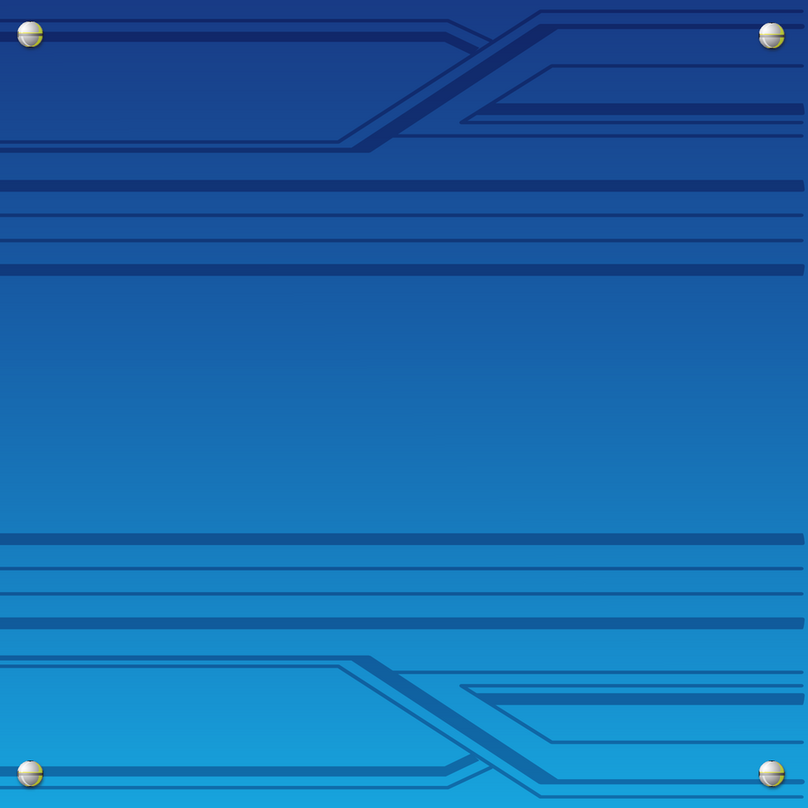
The Learning Journey
The Learning Journey Techno Gears Marble Mania Velocity instruction manual

Maxford
Maxford 40" EP Gee Bee Y Scale ARF V2 instruction manual

Eduard
Eduard ZOOM FE 949 manual

Eduard
Eduard Mi-24 black interior (Mi-35) quick start guide
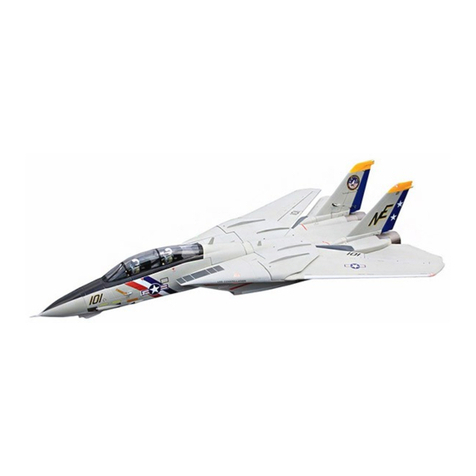
Freewing
Freewing F-14 TOMCAT user manual
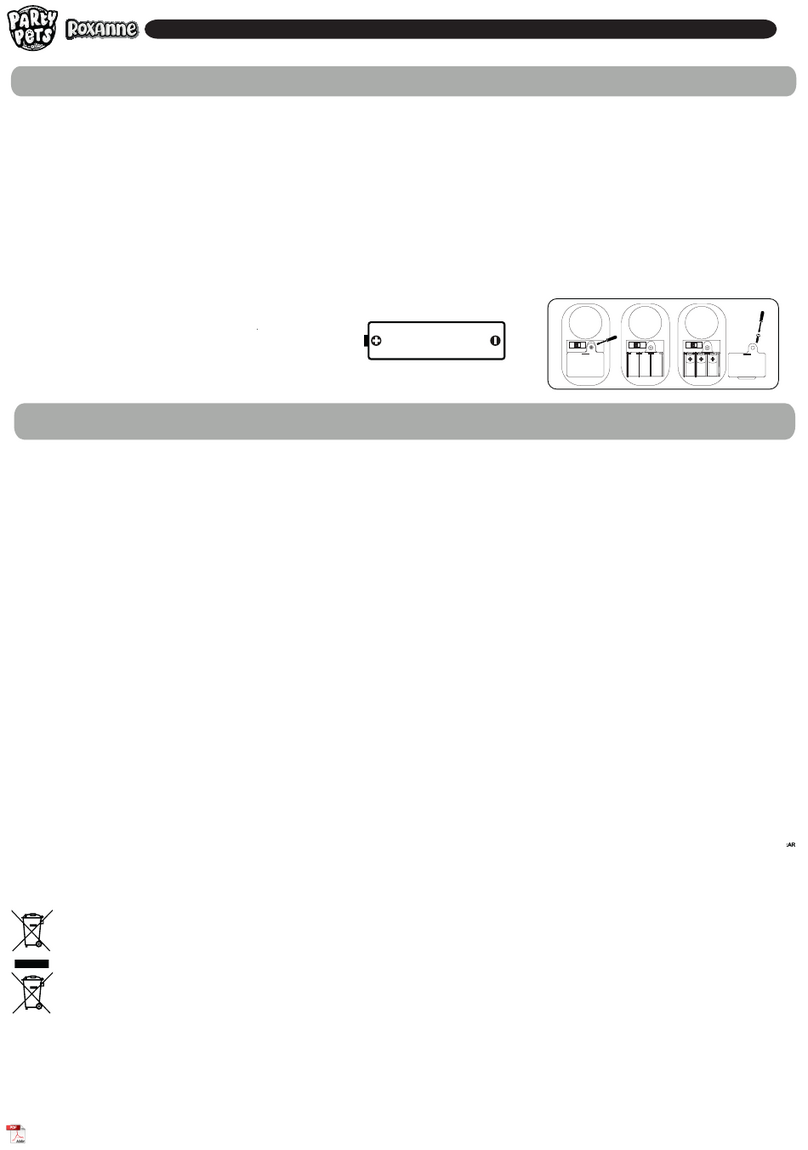
Party Pets
Party Pets Roxanne Instructions for use


